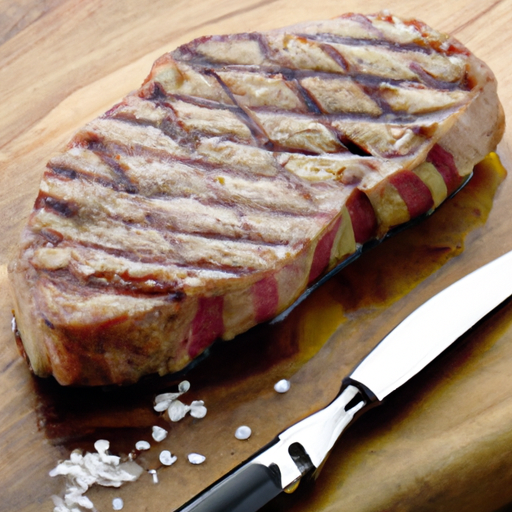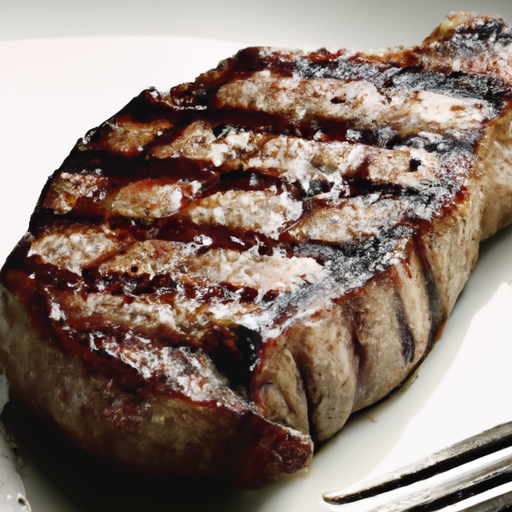Imagine never having to worry about overcooking or undercooking your meals again. With the “Ultimate Guide: Cooking Temperature Chart,” you’ll have all the information you need to achieve perfectly cooked dishes every time. This comprehensive guide provides a wide range of cooking temperatures for various types of meat, poultry, fish, and even baked goods. Whether you’re a seasoned chef or just starting to explore the kitchen, this essential tool will be your trusted companion, ensuring that your meals are cooked to perfection. Say goodbye to guesswork and hello to culinary confidence with the “Ultimate Guide: Cooking Temperature Chart.”

Understanding Cooking Temperatures
What Are Cooking Temperatures?
Cooking temperatures refer to the specific heat levels at which different foods are cooked. It is crucial to understand these temperatures to ensure that your meals are not only delicious but also safe to consume. By knowing the appropriate cooking temperatures, you can achieve the desired doneness and avoid undercooked or overcooked dishes.
Why Are Cooking Temperatures Important?
Cooking temperatures play a vital role in ensuring food safety and overall culinary success. When meat, poultry, fish, or other perishable foods are cooked at the proper temperature, harmful bacteria are eliminated, reducing the risk of foodborne illnesses. Additionally, cooking at the right temperature allows the flavors to develop fully, resulting in a perfectly cooked and mouthwatering dish.
Different Types of Cooking Temperatures
There are three main types of cooking temperatures: low heat, medium heat, and high heat. Each type is used for various cooking methods and serves a specific purpose in achieving the desired outcome and texture of the dish.
Cooking Temperature Ranges
Low Heat
Low heat is typically between 200°F (93°C) and 325°F (163°C). This temperature is used for slow cooking methods, such as braising, stewing, and simmering. Slow-cooking at low heat allows the flavors to meld together and results in tender and flavorful dishes.
Medium Heat
Medium heat usually ranges between 325°F (163°C) and 375°F (190°C). It is commonly used for sautéing, stir-frying, and baking. This temperature range provides enough heat to cook food relatively quickly while allowing even browning and caramelization.
High Heat
High heat falls between 375°F (190°C) and 500°F (260°C). This temperature range is ideal for searing, roasting, grilling, and broiling. Cooking at high heat quickly develops a savory crust, seals in juices, and creates a delightful charred flavor.
Cooking Techniques and Recommended Temperatures
Roasting
Roasting is a cooking technique that involves dry heat in the oven. It is commonly used for meat, poultry, and certain vegetables. The recommended temperature for roasting varies depending on the food being cooked. For example, roasting a chicken is typically done at 350°F (175°C), while roasting a rack of lamb might require a higher temperature of 400°F (204°C) or more.
Grilling
Grilling is a popular outdoor cooking method that uses direct heat. The temperature for grilling varies depending on the type and thickness of the food. Grilling a thick steak usually requires high heat at around 400°F (204°C) to achieve a perfectly juicy and charred exterior while maintaining a tender center.
Baking
Baking involves cooking food in an enclosed space, such as an oven. It is commonly used for bread, cakes, pastries, and casseroles. The temperature for baking varies depending on the recipe. Baking bread, for instance, typically requires a higher temperature between 375°F (190°C) and 425°F (218°C), while baking a cake may require a lower temperature around 325°F (163°C).
Searing
Searing is a quick and high-heat cooking method used to brown the surface of meat or fish. A hot skillet or grill is essential for achieving a flavorful crust. The ideal temperature for searing ranges from 400°F (204°C) to 450°F (232°C), ensuring a beautiful caramelization while keeping the interior tender and moist.
Sautéing
Sautéing is a versatile cooking technique that involves cooking food quickly in a skillet with a small amount of fat. The recommended temperature for sautéing is typically medium heat, around 325°F (163°C) to 375°F (190°C), allowing the food to cook evenly without burning or drying out.
Steaming
Steaming is a gentle cooking method that uses the heat of steam to cook food. It is often used for vegetables, seafood, and dumplings. The recommended temperature for steaming ranges from 212°F (100°C) to 220°F (104°C), creating moist and tender results while preserving the natural flavors and nutrients.
Poaching
Poaching involves cooking food in a liquid at a low and gentle temperature. It is commonly used for delicate foods such as eggs, fish, and fruits. The ideal poaching temperature falls between 160°F (71°C) and 180°F (82°C), ensuring a tender texture without overcooking or breaking apart.

Internal Temperatures for Different Meats and Seafood
To ensure food safety, it is crucial to cook meats and seafood to the appropriate internal temperature. Here are the recommended internal temperatures for various types of meat and seafood:
Beef
- Rare: 125°F (52°C)
- Medium rare: 135°F (57°C)
- Medium: 145°F (63°C)
- Medium well: 150°F (66°C)
- Well done: 160°F (71°C)
Pork
- Medium rare:145°F (63°C)
- Medium: 150°F (66°C)
Poultry
- Chicken breast: 165°F (74°C)
- Chicken thigh: 175°F (79°C)
- Whole chicken: 165°F (74°C)
- Duck: 165°F (74°C)
- Turkey: 165°F (74°C)
Lamb
- Rare: 135°F (57°C)
- Medium rare: 145°F (63°C)
- Medium: 160°F (71°C)
- Well done: 170°F (77°C)
Fish
- Fish fillets and steaks: 145°F (63°C)
- Whole fish: 145°F (63°C)
- Shrimp and shellfish: 145°F (63°C)
Shellfish
- Clams, mussels, and oysters: Until shells open
- Lobster and crab: 145°F (63°C)
Safe Internal Temperatures for Other Foods
In addition to meats and seafood, it is important to know the safe internal temperatures for other types of foods:
Eggs
- Egg dishes: 160°F (71°C)
Dairy Products
- Casseroles with dairy: 160°F (71°C)
Casseroles
- Casseroles with meat: 165°F (74°C)
Leftovers
- Leftovers: 165°F (74°C)
Ground Meats
- Ground beef, pork, veal, and lamb: 160°F (71°C)
Cooking Temperatures for Breads and Pastries
When it comes to breads and pastries, the internal temperature is just as important as the baking temperature. Here are the recommended internal temperatures for different types of breads and pastries:
Yeast Breads
- Yeast bread: 190°F (88°C) to 200°F (93°C)
Quick Breads
- Muffins and quick breads: 190°F (88°C) to 200°F (93°C)
Pastries
- Puff pastry: 400°F (204°C) until golden brown
- Pie crust: 375°F (190°C) until golden brown
Temperature Conversion Guide
It is essential to have a temperature conversion guide handy when using recipes with different temperature units. Here are the conversions between Celsius and Fahrenheit:
Celsius to Fahrenheit
- Celsius temperature × 9/5 + 32 = Fahrenheit temperature
Fahrenheit to Celsius
- (Fahrenheit temperature – 32) × 5/9 = Celsius temperature
Using a Meat Thermometer
A meat thermometer is an invaluable tool for monitoring the internal temperatures of your cooked foods. Here’s what you need to know about using a meat thermometer:
Types of Meat Thermometers
There are two main types of meat thermometers: instant-read thermometers and leave-in thermometers. Instant-read thermometers are inserted into the food and give a quick temperature reading, while leave-in thermometers can be left inside the food during the cooking process, providing continuous temperature monitoring.
How to Use a Meat Thermometer
To use a meat thermometer, insert the probe into the thickest part of the food, making sure not to touch bone or fat. Wait for the temperature reading to stabilize, and then remove the thermometer. For leave-in thermometers, follow the manufacturer’s instructions for proper placement.
Tips for Accurate Temperature Reading
- Clean and sanitize your meat thermometer before and after each use.
- Insert the thermometer into the thickest part of the food for an accurate reading.
- Avoid touching bone or fat with the thermometer probe, as this can result in inaccurate readings.
- For large cuts of meat, take multiple temperature readings in different areas to ensure even cooking.
Food Safety Tips
Maintaining proper food safety practices is crucial to prevent foodborne illnesses. Here are some essential food safety tips to follow:
Storing Food Properly
- Store raw meats, poultry, and seafood in separate containers or bags to prevent cross-contamination.
- Keep perishable foods, such as meats, dairy, and leftovers, refrigerated at or below 40°F (4°C).
- Use refrigerated leftovers within 3-4 days to ensure freshness and safety.
Thawing Meats
- Thaw frozen meats in the refrigerator, under cold running water, or in the microwave using the defrost setting.
- Avoid thawing meats on the countertop, as it allows bacteria to multiply rapidly.
Avoiding Cross-Contamination
- Wash your hands thoroughly with soap and water before and after handling raw meats, poultry, or seafood.
- Clean cutting boards, utensils, and countertops with hot, soapy water after every use to prevent cross-contamination.
- Keep cooked foods separate from raw foods to avoid bacterial contamination.
Conclusion
Understanding cooking temperatures is essential for anyone who enjoys preparing delicious meals at home. By knowing the appropriate temperatures for different cooking techniques and types of foods, you can ensure food safety, achieve desired flavors and textures, and create memorable culinary experiences. Remember to use a meat thermometer, follow food safety guidelines, and embrace the versatility that cooking temperatures offer to unleash your inner chef. Happy cooking!
